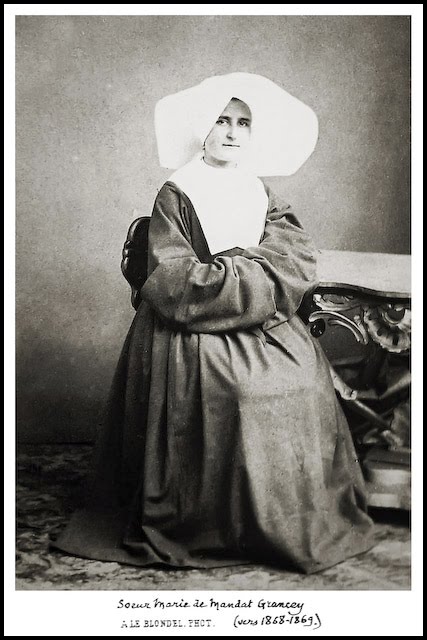Father Jung’s archaeological team relaxed for two weeks, scheduled another trip and then returned to obtain scientific proof of their finding of Mary’s house. On the third day Father Jung celebrated the first Mass at Panaghia Capouli.
Gregory of Tours (538-594) in The Book of Miracles, a work in which history and legend are sometimes intimately mixed, was the first ecclesiastical writer to speak of a chapel situated on a mountain near Ephesus. He stated, “On the summit of a mountain near Ephesus there are four walls without a roof. John lived within these walls.”
The people of Kirkince (now Sirince), a village about 17 kilometers from Meryem Ana, traditionally believed there had been a house on Bulbul-Dagi (Nightingale Hill) where Mary had lived. Every year on Assumption Day they made a pilgrimage to Panaya Kapulu (Chapel of the All Holy), now Meryem Ana Evi. They believed that Mary was raised up to heaven from this place. This may have seemed strange that a group of Orthodox villagers should believe this when the rest of their church had believed since the Middle Ages that she spent her last days in Jerusalem.
The next two weeks, the archaeology team rested and discussed the next steps in their amazing discovery of Mary’s house. They were eager to go deeper into their findings and set 12 August for their next trip. This time Fathers Poulin and Jung would be included along with four others. They determined it would be most inappropriate to publicize their finds now. At this time, it had to be their secret; there had to be scientific proof.
They also remembered those ten years earlier, when Father Julian Gouyet came through here with the same idea. He said he had found what he believed was the remains of Mary’s Home. The whole matter had been dropped with “subtle insistence” because there was such a great veneration for her home to have been in Jerusalem.
Father Poulin kept a critical account of the findings. He knew that when it was published it would be most provocative. To specifically record and verify all their findings and possibly learn new ones, the trip was made from 19-25 August 1891. On 23 August 1891 the first Mass was celebrated on the Altar of Mary’s House (Panaghia). This was during the third expedition. Father Jung led the group; with him were Fathers Borrel, Paul d’Andria, Heroguer, and non-priests Pelecas and Constinin. On the round massif of the sanctuary, Andreas (an acquaintance of Pelecas living on the mountain) made a shaky table out of three old wooden shelves. On this altar, Father Jung celebrated Mass in Latin, the first Mass at the site of Mary’s Home, the Panaghia Capouli.
Afterwards, they drew maps, did sketches, took pictures and recorded each of their endeavors. There was just one major difficulty: According to Sister Anne Catherine’s revelations, the house was supposed to be octagonal. But from the back it looked round and yet somewhat octagonal. It took them three more years to dig deeper and after they uncovered in depth about a yard of dirt, they found a perfectly octagonal figure on which the original structure had been built.
Again, it was just as Anne Catherine had said. They took all the dimensions of the Home as they found it, its individual rooms, the changes made within the Home, the distances to the sea and to Ephesus, the height of the mountain, and everything they could measure, they recorded. The house had an aura of holiness and peace that affected them all.
The distance from Panaghia Capouli to the sea is four kilometers in a direct line. Altitude is 610 meters. One can see Samos. There was no longer any doubt possible. This was, indeed, the house described by the visionary.
The Vincentian fathers had taken pictures on this occasion and published everything later in their 1896 book “Panaghia or the House of the Blessed Virgin Mary Near Ephesus.”
More compelling evidence that the early church affirmed Mary’s place at Ephesus lies in the fact that the Third Ecumenical Council of the Catholic Church was held in Ephesus (AD 431).
“This council, which met in a large cathedral known as the Double Church of St. Mary, was primarily called to formalize the doctrine known as ‘Theotokos,’ Greek for ‘Mary, Mother of God.’
To name a church after a Saint, according to Canon Law at that time, required that person to actually live or die in the vicinity.
Furthermore, coincidence alone would not have sufficed to decide to hold a Council in Ephesus to define a doctrine concerning Mary as the Mother of God.
Benedict XIV, an outstanding scholar, in his treatise on the Feast of Good Friday and in his treatise on the Feast of the Assumption wrote:
“John amply fulfilled Christ’s orders; in every way he forever cared for Mary with a sense of duty; he had her live with him while he remained in Palestine, and took Her with him when he departed for Ephesus where the Blessed Mother at length proceeded from this life into Heaven.” He went further by stating that “this is the opinion of the Church Universal.”
Segment 16: Sister Marie and Fathers Poulin and Jung discuss purchasing Panaghia.
Sr. Marie De Mandat-Grancey Foundation
P.O.Box 275
Cold Spring Harbor, NY 11724 USA
P.O.Box 275
Cold Spring Harbor, NY 11724 USA
" I am not a priest and cannot bless them, but all that the heart of a mother can ask of God for her children, I ask of Him and will never cease to ask Him." ~ Sister Marie

“The grace of our Lord be with us forever.” ~ Sr. Marie









